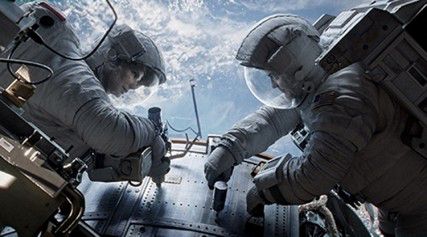
Within the first 15 minutes of Gravity, as the camera slowly floats toward Dr. Stone (Sandra Bullock), the viewer may experience that fine moment when the action feels tangible — except, for him or her, it is in three dimensions. The camera does not cut for what seems like an impossibly long time. The screen between our reality and the world in the film falls away. The strange knot in our stomach of inevitable misfortune arises, as if we were in danger ourselves. In this realization, the question arises: How can such infinite space feel so claustrophobic?
Gravity is a film that appeals to the viscera, not to the head. Alfonso Cuarón — director of movies such as Children of Men and Y Tu Mamá También — set out to make his first 3D project, which happens to be his most gut-wrenching film to date.
Sandra Bullock plays Dr. Stone, the scientist who flees Earth to escape a lonely past. Of course, conflicts arise as the film persists and Stone questions her life’s worth in the face of looming death. The film catalyzes with a Russian missile strike intended to shoot down its own outdated satellite. However, the Russians do not anticipate the debris created from the collision, which consequently orbits around Earth faster than a bullet. The fragments become the antagonist of the film, causing a seemingly unending string of difficulties.
It is in these difficulties that the film either swims or sinks. At times, the obstacles feel perfectly warranted. At other times, however, almost too much goes wrong, to the point that it is either too unlucky to be believable or the more likely option: Stone would be dead by now.
This is true existential cinema, but says nothing new about humanity’s predicament in the face of meaninglessness. Stone parallels Camus’s Sisyphus, although Cuarón uses a cheap trick that dilutes Stone’s strength as an active protagonist. Cuarón would probably argue that Stone’s latent inspiration comes from within, but his way out is unsatisfying and much too psychological for a film that is otherwise about external events.
At its worst, the film deals more with caricatures than with characters, and it flirts with sentimentality. These attempts to make Stone sympathetic are unnecessary, as anyone would come to feel sympathy for her after suffering such improbable trials. The dignity in her striving is clear and there is no need to make Stone the “woman who lost everything.”

These were truly the weakest parts of the film, along with the use of score music where silence would have been more effective. How could Cuarón fill the moments in space with music when the film opens with the words “space is silent”? When watching the more action-packed sequences, imagine them occurring in silence and the haunting implications of such a choice. Cuarón does not stray far from what his audience expects, but he could have taken greater risks with a project that rewards unusual style.
Yet there is still worth in seeing the human spirit’s inexhaustible persistence play out in 3D. And what better place than the nothingness of space, where man’s fate comes down to the devices he’s built for himself to speckle the vast emptiness? This seems like the main exploration of the film, addressing questions such as “how does technology both put people at risk and also save their lives?” and “how does technology operate in this paradoxical form where humans are put at risk?”
The other subtle brilliance of the film is its slowness. Watching humans helplessly float at the mercy of gravity-less space is agonizing and inherently suspenseful, especially when oxygen runs low and the space station is far out of reach. Hitchcock may have made such a film, had he the technology and sci-fi-oriented imagination.
Shot in 3D, Gravity’s format augments Cuarón’s signature long-take style. He understands that a continuous take is closer to life — as we do not “cut” in our heads to different angles and scenes — and has chosen to use three dimensions to bring audiences that much closer. Perhaps it is too obvious a move, or perhaps it is the golden mean of filmmaking technology enhancing a story.
James Cameron has already praised it as “the best space film ever,” but who ever trusted Cameron’s opinion, or mine? Gravity is a film that must be seen in 3D. The experience somehow feels more immediate and jarring than many other films, and the audience will have to remind themselves to relax their muscles and close their agape mouths during the experience.
This is an account occasionally used by the Daily Free Press editors to post archived posts from previous iterations of the site or otherwise for special circumstance publications. See authorship info on the byline at the top of the page.













